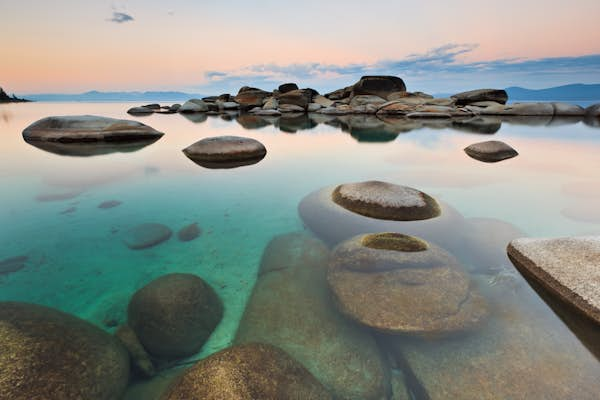It’s never been a better time to plan a trip to Lake Tahoe. The gorgeous crystalline waters in North America’s largest alpine lake are the clearest they’ve been since the 1980s, according to a new study – but the effect may only last a couple of years.
Scientists with the Tahoe Environmental Research Center (TERC) at the University of California, Davis report that a shift in two of the lake’s animal populations was largely responsible for the improvement in visibility. Microscopic animals called Daphnia zooplankton, which eat the particles clouding the water, declined when the population of their main predator, the invasive and aggressive Mysis shrimp, surged. But the shrimp population “unexpectedly crashed” two years ago, said the study, causing zooplankton to rebound and get back to work. They eat phytoplankton, other microscopic animals in the lake, as well as tiny clay particles, both of which cloud the water. “Essentially, they’re little Roombas cleaning up the lake,” TERC director Geoffrey Schladow told NPR.

The research team measures water clarity using a small tool called a Secchi disk, which is lowered into the lake until it’s no longer visible. The average annual clarity measurement saw an improvement from 2021 (61 feet) to 2022 (71.7 feet), with current predictions for a further increase in 2023. “The goal is to bring the clarity back to 97.4 feet,” reports the EPA.
Tahoe is one of the deepest lakes in the world, and one of the oldest, at 2 million years old, per the Lake Tahoe Tourism Board. Set in the Sierra Nevada along the border of California and Nevada, the lake has long been a year-round vacation hot spot due to its stunning natural beauty.

Augmenting the resurgence of zooplankton is an effort among Lake Tahoe’s hotel industry leaders to keep the waters clean and reduce pollution. The Ritz-Carlton Lake Tahoe and the Edgewood Tahoe Resort have both partnered with community clean-up organizations as well as plastic- and sediment-reduction initiatives.
But there may be a finite window for this particular pinnacle of lake cleanliness, scientists say. The shrimp population is likely to make a comeback, and “once they do that, Daphnia will disappear, and clarity will go back to what it had been,” said Schladow. “It may last maybe two years, maybe a little longer.”
